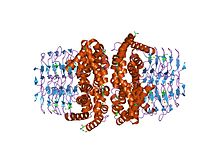Serine O-acetyltransferase
| serine O-acetyltransferase | |||||||||
|---|---|---|---|---|---|---|---|---|---|
 Serine acetyltransferase hexamer, Haemophilus influenzae | |||||||||
| Identifiers | |||||||||
| EC no. | 2.3.1.30 | ||||||||
| CAS no. | 9023-16-9 | ||||||||
| Databases | |||||||||
| IntEnz | IntEnz view | ||||||||
| BRENDA | BRENDA entry | ||||||||
| ExPASy | NiceZyme view | ||||||||
| KEGG | KEGG entry | ||||||||
| MetaCyc | metabolic pathway | ||||||||
| PRIAM | profile | ||||||||
| PDB structures | RCSB PDB PDBe PDBsum | ||||||||
| Gene Ontology | AmiGO / QuickGO | ||||||||
| |||||||||
In enzymology, a serine O-acetyltransferase (EC 2.3.1.30) is an enzyme that catalyzes the chemical reaction
- acetyl-CoA + L-serine CoA + O-acetyl-L-serine
Thus, the two substrates of this enzyme are acetyl-CoA and L-serine, whereas its two products are CoA and O-acetyl-L-serine.
This enzyme belongs to the family of transferases, specifically those acyltransferases transferring groups other than aminoacyl groups. The systematic name of this enzyme class is acetyl-CoA:L-serine O-acetyltransferase. Other names in common use include SATase, L-serine acetyltransferase, serine acetyltransferase, and serine transacetylase. This enzyme participates in cysteine metabolism and sulfur metabolism.
Structural studies
[edit]As of late 2007, 7 structures have been solved for this class of enzymes, with PDB accession codes 1S80, 1SSM, 1SSQ, 1SST, 1T3D, 1Y7L, and 2ISQ.
N terminal protein domain
[edit]| SATase N terminal domain | |||||||||
|---|---|---|---|---|---|---|---|---|---|
 The structure of the enzyme serine acetyltransferase- apoenzyme (truncated) | |||||||||
| Identifiers | |||||||||
| Symbol | SATase_N | ||||||||
| Pfam | PF06426 | ||||||||
| InterPro | IPR010493 | ||||||||
| |||||||||
In molecular biology, the protein domain SATase is short for Serine acetyltransferase and refers to an enzyme that catalyses the conversion of L-serine to L-cysteine in E. coli.[1] More specifically, its role is to catalyse the activation of L-serine by acetyl-CoA.This entry refers to the N-terminus of the protein which has a sequence that is conserved in plants and bacteria.[2]
Importance of function
[edit]The N-terminal domain of the protein Serine acetyltransferase helps catalyse acetyl transfer. This particular enzyme catalyses serine into cysteine which is eventually converted to the essential amino acid methionine. Of particular interest to scientists, is the ability to harness the natural ability of the enzyme, Serine acetyltransferase, to create nutritionally essential amino acids and to exploit this ability through transgenic plants. These transgenic plants would contain more essential sulphur amino acids meaning a healthier diet for humans and animals.[3]
Structure
[edit]The amino-terminal alpha-helical domain particularly the amino acid residues His158 (histidine in position 158) and Asp143 (aspartic acid in position 143) form a catalytic triad with the substrate for acetyl transfer.[4] There are eight alpha helices that form the N-terminal domain.[4]
References
[edit]- ^ Denk D, Böck A (March 1987). "L-cysteine biosynthesis in Escherichia coli: nucleotide sequence and expression of the serine acetyltransferase (cysE) gene from the wild-type and a cysteine-excreting mutant". J. Gen. Microbiol. 133 (3): 515–25. doi:10.1099/00221287-133-3-515. PMID 3309158.
- ^ Saito K, Yokoyama H, Noji M, Murakoshi I (July 1995). "Molecular cloning and characterization of a plant serine acetyltransferase playing a regulatory role in cysteine biosynthesis from watermelon". J. Biol. Chem. 270 (27): 16321–6. doi:10.1074/jbc.270.27.16321. PMID 7608200.
- ^ Tabe L, Wirtz M, Molvig L, Droux M, Hell R (March 2010). "Overexpression of serine acetlytransferase produced large increases in O-acetylserine and free cysteine in developing seeds of a grain legume". J. Exp. Bot. 61 (3): 721–33. doi:10.1093/jxb/erp338. PMC 2814105. PMID 19939888.
- ^ a b Pye VE, Tingey AP, Robson RL, Moody PC (September 2004). "The structure and mechanism of serine acetyltransferase from Escherichia coli". J. Biol. Chem. 279 (39): 40729–36. doi:10.1074/jbc.M403751200. PMID 15231846.
- Kredich NM, Tomkins GM (1966). "The enzymic synthesis of L-cysteine in Escherichia coli and Salmonella typhimurium". J. Biol. Chem. 241 (21): 4955–65. doi:10.1016/S0021-9258(18)99657-2. PMID 5332668.
- Smith IK, Thompson JF (1971). "Purification and characterization of L-serine transacetylase and O-acetyl-L-serine sulfhydrylase from kidney bean seedlings (Phaseolus vulgaris)". Biochim. Biophys. Acta. 227 (2): 288–95. doi:10.1016/0005-2744(71)90061-1. PMID 5550822.

